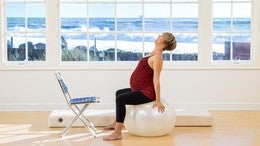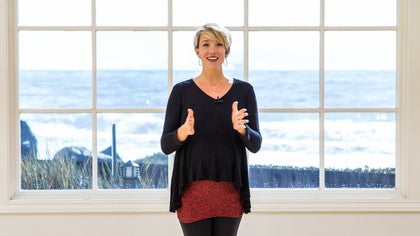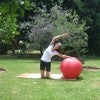Description
About This Video
Transcript
Read Full Transcript
Hi, I'm Leah Stewart and I am here to give you a little bit of an introduction to kind of a new series that I'm presenting here in plots. Anytime I have had the honor of teaching throughout each of my pregnancies here on place any time. And over that time I've really started to dive deeper into prenatal PyLadies work and kind of what it can look like and what it actually means for women during their pregnancy. And what that's led me to do is actually to kind of start to develop a way to help you as a pregnant women or if you're here as an instructor wanting to work with pregnant women and how to work with them. It's kind of to help you learn how you can translate all of that work that you did during your pregnancy and how you can translate that into your labor and birth experience.
So there's four separate classes in this series and the series is really meant to bridge the gap between the Prenatal Palladio's work and postnatal police work in the [inaudible] world and also in the fitness world. We've done a really, really great job of giving women some fantastic options for exercise during pregnancy and exercise after birth. And we really helped them to feel healthy and empowered and wonderful, but we really haven't taken advantage or full advantage of the tools that Palladia is really gives us to use during labor and birth. So if we study the history of [inaudible] and really Joseph PyLadies intention behind what he originally called control Ajai, we start to see that his practice was really much more than just a set of exercises. It was really about the exercises or the external physical tool in which we gained the necessary physical, mental, and even emotional attributes to prosper in our daily life. The evidence of a successful plot is practice isn't just in what we look like and we and those of us who have really practiced melodies for a long time, and maybe even some of us who've just practiced it for the first time, we kind of get this sense that there's something deeper going on.
There's something much more than just our physical aesthetic. And so what we have is what I call these coal vert elements of plots. And these are gonna include things like heightened body awareness, um, confidence, increased focus, movement, clarity and efficiency, pain free movement while exercising and in everyday life. And the balance of muscular strength and flexibility and how to use those in tandem and also the, the wonderful quality of healing and energizing breath. And those are kind of what's really deeply rooted behind the, these exercises that Joseph [inaudible] created so many years ago when potties practitioners really kind of get into these deeper covert qualities.
It's evident in everything that they do and every movement that they make, um, how they walk, how they present themselves. And in some cases people start to even see how it kind of manifest and kind of how they kind of handle themselves mentally. Um, and even emotionally in certain circumstances and give in their life and their life's journey. Like, I don't know, having a baby, right? So it can really translate to some of those things. If we look at what's needed for a healthy, empowered, intentional, peaceful, joyful, gentle birth, we start to see that much of the qualities of PyLadies can really help us achieve some of those goals. And we see some of these qualities presented to us in birthing classes like lamaze or the Bradley method or hypnobirthing classes.
And what I kind of started to see over the years is that is actually is very similar and provides a lot of these same tools. So we really need to start looking at how platas can translate into the labor and birth experience. So it's really a wonderfully designed program to accomplish those goals. Now that doesn't mean you're going to be in the throws of labor doing a rollover or doing the teaser or doing a pelvic curl. That's not what I need at all. So in this situation, the is exercises. They take a little bit of a backseat, meaning some of the exercises that we intentionally do during our [inaudible] classes or during our plotty session.
So they take a backseat and those covert qualities that I spoke about earlier, those come to the forefront. Those really come to shine in the experience of labor and birth and the exercises or the movement qualities, they take on a different form during labor and birth and lit slightly different form than what we practiced in prenatal, but the benefits that we gained from practicing them, they translate into labor and birth. In this series, I'm hoping to show you what you've practiced and all that you've gained from it, how you're going to be able to use it intentionally and even subconsciously during your labor and birthing experience. If you're watching these classes to get like a really good rockin prenatal PyLadies workout class, I'm gonna stop you right now because that's not the intention of these classes. There is some movement based, but if you want a good prenatal PyLadies workout, push, pause, go back and go check out my other [inaudible] classes, prenatal platas classes, and all of the other wonderful instructors on the plots anytime website. So go back and watch those.
Then when you're ready to kind of prepare yourself for how you're going to translate that work into labor, then you come back, watch this intro and start doing these four classes in this series. In these four classes, I want to provide you with three different things. So one is going to be a theme or ability that I believe professionally to be crucial during labor and birth. So that's the first thing I'm kinda kind of talk about and explain number two is in some of the classes I'm actually going to be doing some like little exercise or movement sequences. So it's gonna feel a little bit more like a workout in some of the classes they're going to feel a little bit more like I'm demonstrating a certain position and why it would be advantageous for you to maybe consider during your labor and birth. So you're going to kind of get a little bit of both.
And then the um, number three is going to be of course a detailed explanation of what I'm doing and why I'm doing it. And so when you're looking at these classes, you're free to move with me. And to experience the movement, um, you're also free to just sit there and take notes and then just kinda think about it and let it absorb. So either way, it's gonna work. Um, it's really just about you kind of seeing how you can again, translate that work into your labor and birth experience. Now, here's the tricky part about me teaching you this series is I obviously have no idea how or in what situation you're going to be having your baby. I don't know the reality of how you're going to be able to implement some of this stuff. And to be quite frank with you, that's not really the purpose of what I'm doing. So my purpose is never to tell you how you should be giving birth. Um, my desire is for you to feel confident and peaceful within your birthing choices and also within the birthing circumstances that you're put into, whether intentionally or unintentionally. So that's really important for me to unfor you to understand is that I'm not telling you how you should have a baby.
I just want you to experience that confidence and that knowledge and that joyfulness of having confidence and knowledge that comes with whatever circumstance is right for you and your baby when that baby enters the world. So for some of you, this means that you'll be able to use what I show you throughout your entire labor process, from the first contraction to the birth of the placenta, and you'll be able to move around and you'll be able to do what feels good on your body. For some of you, this means that to what I show you will work in maybe smaller spurts, um, maybe before the doctors prepare you or prep your body for your Syrian section, or perhaps before you're hooked up to the IV in the hospital and you're kind of bound to the bed after that point. Or perhaps it doesn't look so much like a physical manifestation, like you being able to get into the kneeling position during labor, but maybe it's more of the imagery and the breath sequencing that you use. So how you're going to be able to implement what I show you. It's gonna look really different to the situations you could control and the situations you can't control.
So that's important that you understand that as well. So I want to be able to use these resources in whatever way is right for you. And finally I just want to reiterate that my training is in Paladins and in human movement and anatomy. That is where I've been trained and that's where I've worked within this prenatal community. Um, I've studied [inaudible], I've study human anatomy for a long time and I've also studied birth and labor and everything that comes along with it for a long time. I have given birth to two little boys naturally using the elements of [inaudible] like movement, mobility, breath awareness, focus that have really been beneficial for me and my children and for my husband as well, who's been my birth partner and I'm ready to give birth in about six weeks here to my third baby.
And I've also have received dozens upon dozens of fantastic feedback from PyLadies practitioners like yourself who have taken some of this work. Taking some of the things and some of the exercises that we've done and have given feedback about how wonderful it felt for them during their labor and birth experience. So those are kind of some the things that really have encouraged me to step even deeper into this work. And I'm so grateful for pull ideas in time to allow me to, um, to kind of present the work on their website. And so I really hope that you enjoyed this series and that you learn from this series. Again, you can move with me, you can sit and take notes.
There's going to be some movement involved, there's and be a lot of explanation involved. So again, these aren't workout classes per se. I will always respond to your comments and your feedback. Please let me know what you think. Please ask questions that will try to clarify anything that I can in the best way possible. And most importantly, take what resonates for you from this series. Watch it, practice it, think about it. Let it absorb into your mind and body. Make changes, make alterations that work better for you.
Leave out things that don't work for you. Um, you know, make those little adjustments that work for you. Think about how you might realistically able to apply these into your breathing situation and circumstance. These techniques are not set in stone. They are designed for you to take and for you to make personal for yourself. And there a launching pad from which you can explore what feels good for your body, what feels good for you in your situation, so that you can have a wonderful, wonderful birthing experience. Thank you so much. And let's get started with our first class.
Prenatal Pilates: Pilates Birthing Series
Comments
You need to be a subscriber to post a comment.
Please Log In or Create an Account to start your free trial.






















